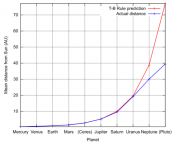Title: Possible Disintegration Short-Period Super-Mercury Orbiting KIC 12557548
First Author: S. Rappaport
First Author Institution: MIT

The stacked (and binned) light curve. The light curve is depressed following the primary occultation.
To think that little more than 2 decades ago we didn’t know for sure if any other stars had planets. Now we not only know they exist, but some are far weirder than we could possibly imagine. A new observation from Kepler show a periodically reoccurring transit of what appears to be a planet across its 16th magnitude host K dwarf star. However, the amount of light blocked by the planet (called the depth of the transit) varies each time and is asymmetrical. What’s going on?
Because the depths of the transits are highly variable, the events cannot be due to a single planet of fixed size. That would result in very uniform light curves with periodic symmetric transit events. The authors consider and dismiss the idea that there are two planets in the system in some kind of dynamical dance because of instabilities. They also rule out some kind of eclipsing binary with an accretion disk; theoretical modeling of this scenario cannot reproduce their observations. Their remaining theory involves a transiting planet with about the mass of Mercury whose surface is literally evaporating into space! The planet is orbiting so close to the star (with a period of 15.7 hours!) that the heat and light of the star is causing the surface of the planet to sublimate and create a type of atmosphere. If the planet were geologically active, there could also be a significant amount of dust and macroscopic particles in the atmosphere. If the atmosphere were loaded with dust in this way, and the atmospheric gas could escape through a kind of thermal wind, then dust particles would be dragged along resulting in an obscuring tail of debris.
The authors present simulations which detail this kind of planetary outflow, and how the light curves would be affected. One only loosely constrained parameter is the exact mass of the planet. The authors point out that it must be small, about 2x Mercury’s mass, corresponding to a lifetime of around 0.2 Gyr. If the planet were much smaller, the evaporation time would be much shorter and the probability that we would have seen the planet would be much lower. A larger planet would have enough gravity to prevent the mass loss and this unique light curve would not exist for us to observe. Additional observations are required to learn more about this mysterious looking system, but if confirmed, this would be among the smallest bodies to ever be indirectly detected, and the first extrasolar planet found to be geologically active which would be a major achievement for the field.





Trackbacks/Pingbacks